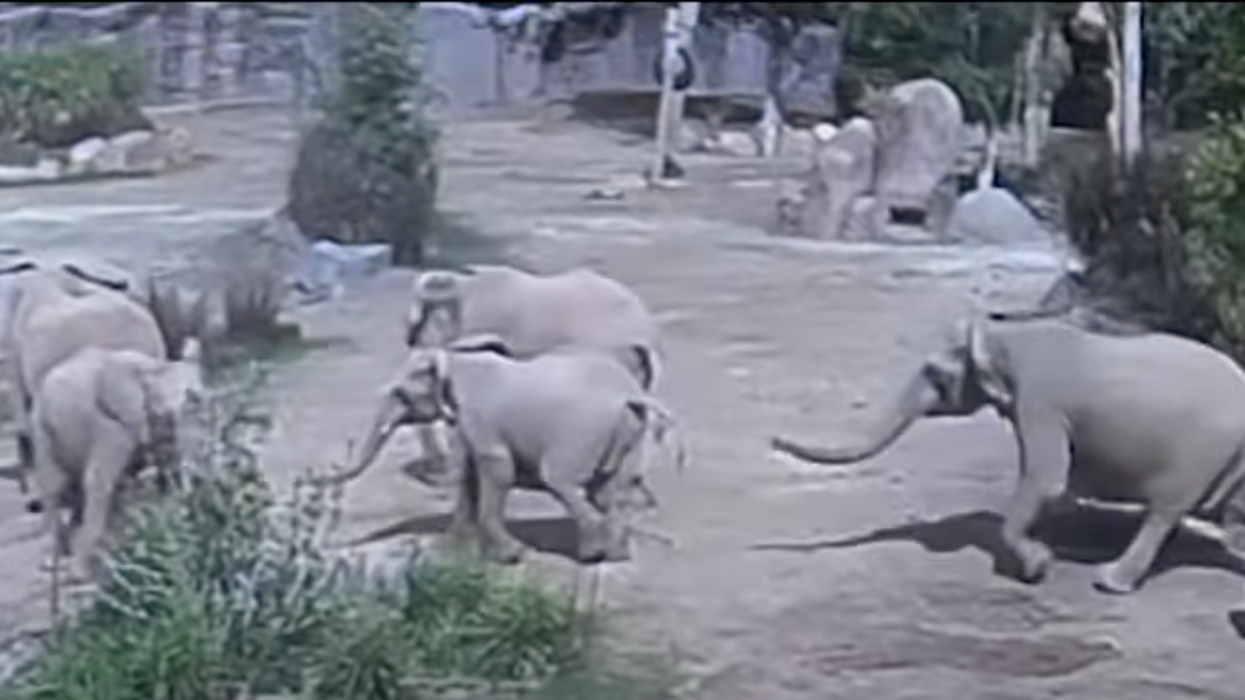Nature is truly amazing.
When a 5.2-magnitude earthquake shook Southern California on Monday, humans braced themselves with the grade school-taught drill to "drop, cover, and hold on." But a herd of African elephants at the San Diego Zoo Safari Park in Escondido, California, coordinated their own "alert circle" drill to stand and protect the herd against seismic danger.
You can see the powerful moment caught by the zoo's security cameras below:
- YouTubeyoutu.be
The San Diego Zoo Wildlife Alliance explained that the three matriarch elephants, named Ndlula, Umngani, and Khosi, quickly huddled around the 7-year-old calves, Zuli and Mkhaya, as a natural response to a potential threat.
They added:
"Elephants have the ability to feel sound through their feet. This video demonstrates the strong social family structure in elephant herds."
African elephants (Loxodonta africana) are known to live in tight-knit groups based around a lead female of the herd. If the matriarch senses danger, she'll lead the herd in an outward-facing circle. Mindy Albright, the curator of mammals at the San Diego Zoo Safari Park, explained that "they sort of freeze as they gather information about where the danger is."
On NPR's program All Things Considered, Joshua Plotnik, an associate professor who studies elephant behavior at Hunter College in New York, remarked that this isn't the first incident of elephants' protective nature, as witnessed during the 2006 Boxing Day Tsunami in Southeast Asia.
"I've heard anecdotes...of elephants responding prior to the large tsunami waves reaching the shores of Thailand, for instance, of elephants retreating up to higher ground with other elephants."
Plotnik says the instinct to protect one another, as shown in the viral video, is a evolutionary strategy to band together when danger is near from predators, stampedes, and even Southern California earthquakes.
He also remarked on why understanding behaviors like this are so critical to protecting elephants, noting:
"The Asian and African elephants are in imminent danger of going extinct, and it's crucially important that we continue to learn more about their behavior and cognition if we're going to come up with ways to protect them and conserve them in the wild."
Elephant enthusiasts on social media found the "alert circle" footage to be incredibly heartwarming.
Comment
byu/ReesesNightmare from discussion
inBeAmazed
So we had an earthquake today, and this beautiful thing happened… pic.twitter.com/YoCfTzZQ6K
— Christopher Webb (@cwebbonline) April 15, 2025
Animals are beautiful pure souls. I love this so much. ❤️
— MM (@adgirlMM) April 15, 2025
Elephants have a great sense of community...
— Jeff G (@jeffgphoenix.bsky.social) April 14, 2025 at 11:52 PM
We could learn so much from these gentle creatures #earthquake #sandiego #sandiegosafaripark #sandiegowildlifealliance #elephants #matriarchy apnews.com/article/eart...
[image or embed]
— icequeenm.bsky.social (@icequeenm.bsky.social) April 14, 2025 at 10:08 PM

People also chimed in after noticing one of the young elephants trying to join the circle.

Comment
byu/ReesesNightmare from discussion
inBeAmazed

Others suggested that perhaps the elephant herd thought a stampede was incoming.
Comment
byu/ReesesNightmare from discussion
inBeAmazed


Sensing that the coast was clear, the herd went back to normal after about four minutes, but stayed close to one another.
Monday's earthquake struck three miles (five kilometers) south of Julian in San Diego County with no reported injuries or property damage to humans—or to elephants.















 @blessedles3/Instagram
@blessedles3/Instagram @lorna_lmw_87/Instagram
@lorna_lmw_87/Instagram @jlynn.xoxox/Instagram
@jlynn.xoxox/Instagram @socy.ward.clark/Instagram
@socy.ward.clark/Instagram @mariafoynz/Instagram
@mariafoynz/Instagram @photowestco/Instagram
@photowestco/Instagram @aplaceinthe_sun/Instagram
@aplaceinthe_sun/Instagram @koltnavaro/Instagram
@koltnavaro/Instagram @smarta007/Instagram
@smarta007/Instagram @heidikansss/Instagram
@heidikansss/Instagram @k.hancock/Instagram
@k.hancock/Instagram @jesse_lynn_81/Instagram
@jesse_lynn_81/Instagram @porche.riley/Instagram
@porche.riley/Instagram


 @realDonaldTrump/Truth Social
@realDonaldTrump/Truth Social @realDonaldTrump/Truth Social
@realDonaldTrump/Truth Social